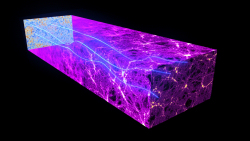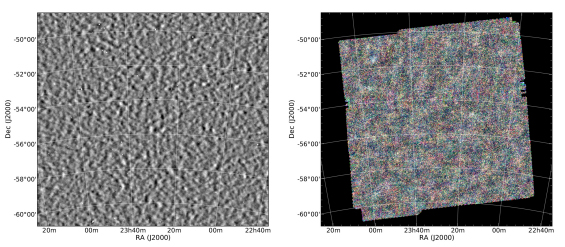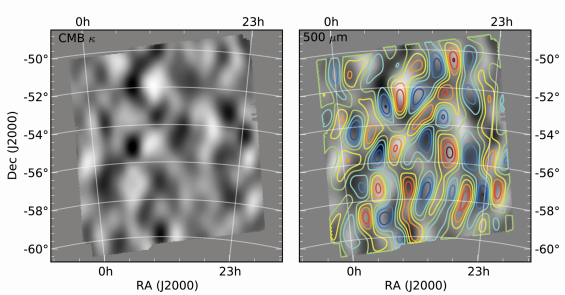Herschel throws new light on oldest cosmic light
1 October 2013
Cosmologists have achieved a first detection of a long-sought component in the Cosmic Microwave Background (CMB). This component, known as B-mode polarisation, is caused by gravitational lensing, the bending of light by massive structures as it travels across the Universe. The result is based on the combination of data from the South Pole Telescope and ESA's Herschel Space Observatory. This detection is a milestone along the way to the possible discovery of another kind of B-mode signal in the polarised CMB - a signal produced by gravitational waves less than a second after the Universe began.The Cosmic Microwave Background is the most ancient light that has travelled almost unimpeded across the Universe, and it contains a wealth of information about the origin and nature of the cosmos. During their journey, photons from the CMB have encountered a multitude of galaxies and galaxy clusters and have been deflected by these large concentrations of matter.
This phenomenon, known as gravitational lensing, imprints a subtle distortion on the pattern of the CMB that encodes details about the large-scale distribution of structure in the Universe. In recent years, cosmologists have detected the signature of gravitational lensing on the CMB temperature using data from ground-based and space-borne experiments, including the first all-sky image of this effect achieved using ESA's Planck satellite.
 |
|
Gravitational lensing of the Cosmic Microwave Background. Credit: ESA and the Planck Collaboration |
A small portion of the CMB is polarised, and gravitational lensing also affects this part of the signal. In fact, the polarised CMB is an additional and even richer treasure trove than the unpolarised signal to use to explore the Universe's past. Now a team of cosmologists studying the polarised CMB has detected in it the signature of gravitational lensing, opening new and exciting possibilities to study the distribution of matter across the cosmos. This result is also the first detection of the elusive second component of the CMB polarisation – the long-sought B-modes.
The study is based on the combination of data from SPTpol, the polarisation-sensitive receiver on the National Science Foundation's South Pole Telescope (SPT), and the SPIRE instrument on board ESA's Herschel Space Observatory. The SPT is a ground-based telescope, located in Antarctica, to observe the CMB to very high angular resolution in a small patch of the southern sky.
"The CMB is partially polarised: this means that it carries additional directional information, like the light that can be observed using polarised glasses," explains Joaquin Vieira from the California Institute of Technology in Pasadena and University of Illinois at Urbana-Champaign, USA. Vieira led the Herschel survey that enabled this result.
"The pattern we observe in polarised light can be split in two distinctive components: we call these E-modes and B-modes. In the case of CMB polarisation, these two components carry very different and complementary information about both the early and the late Universe."
The CMB is the glow from the early Universe, when it first became transparent to radiation, about
"When gravitational lensing distorts the polarised CMB photons, it transforms part of the E-modes into B-modes," explains Vieira.
Only a small fraction of the CMB is polarised, so it is a very weak signal and extremely difficult to detect. The E-mode component of CMB polarisation, which has a stronger intensity than the B-mode one, was first observed in 2002 with the ground-based Degree Angular Scale Interferometer (DASI), and with a variety of other experiments in the following years. The B-modes are an extremely weak signal and, until now, had remained undetected.
"In our study, we combined the polarised CMB observed by SPT with independent data from Herschel. This technique allowed us to finally spot the B-modes induced by gravitational lensing," comments Vieira.
The cosmologists detected the B-mode signal due to gravitational lensing in the data from SPT. To make their detection more robust, they added complementary observations from Herschel to trace the large-scale distribution of galaxies that cause the lensing.
 |
| Joint observation from the South Pole Telescope (left panel) and Herschel (right panel). Credit: Image from G. Holder et al., 2013, The Astrophysical Journal Letters, 771, L16 |
"Herschel offers us a good data set to reconstruct the gravitational potential of the galaxies that are distorting the CMB," says Vieira.
"Including the Herschel data in our analysis made the SPTpol data less sensitive to instrumental effects and was key to isolating the lensing-induced B-mode signal."
With its wide spectral coverage ranging from far-infrared to sub-millimetre wavelengths, Herschel is sensitive to the Cosmic Infrared Background (CIB). In contrast to the CMB, which is the diffuse light from the early Universe, the CIB is a cumulative background, and arose with the formation of stars and galaxies, which started several hundreds of millions of years after the Big Bang.
Whilst stars shine primarily at ultraviolet wavelengths, over the entire age of the Universe roughly half of this energy has been absorbed by cosmic dust within galaxies; this cold dust reradiates starlight at longer, far-infrared wavelengths. For this reason, the CIB encapsulates the cosmic history of star formation.
Galaxies tend to group in galaxy clusters, which are embedded in dark matter halos, and these large concentrations of dark and normal matter are what causes the gravitational lensing of the CMB. For this reason, there is a very strong correlation between the gravitationally-lensed CMB and the CIB detected by Herschel, as the latter traces the lenses responsible for the deflection. By locating points in the sky where more (or fewer) galaxies are present, the extra information contained in the Herschel data allowed the team to see the gravitational lensing effect more clearly.
 |
|
The effect of gravitational lensing on the Cosmic Microwave Background. Credit: Image from G. Holder et al., 2013, The Astrophysical Journal Letters, 771, L16 |
This first result opens a new era in the study of the gravitationally-lensed CMB. So far, cosmologists have successfully studied gravitational lensing on the CMB temperature, but this signal is subject to a large degree of intrinsic noise, and it will be extremely difficult to improve significantly on the best current results. Studying the effect of gravitational lensing in the polarised CMB, instead, is expected to provide a much cleaner probe of the underlying distribution of matter causing the lensing.
"Polarisation holds the key to the future of gravitational lensing studies of the CMB," comments Duncan Hanson from McGill University in Montréal, Canada, who is first author of the paper reporting the discovery.
"This field is in its early stages right now, but as we collect more and more data, we will be able to study the large-scale distribution of matter with ever greater precision."
The study was based on observations with SPTpol together with Herschel data of a large patch of the sky, measuring 100 square degrees, that overlaps with the survey performed with SPTpol.
"It is great to see this ingenious use of Herschel data in achieving the first detection of B-modes in the CMB polarisation, which are fluctuations at a level of one in about ten million," comments Göran Pilbratt, Herschel Project Scientist at ESA.
"This work displays yet another use of the treasure trove of the available Herschel data," he adds.
Apart from its application to gravitational lensing, the discovery of B-modes is a milestone because it proves that it is possible to detect such a signal. Worldwide, cosmologists are still searching for a different type of B-modes, those created by primordial gravitational waves, using experiments including SPT and Planck. Cosmologists believe that the Universe began with a very early phase of accelerated expansion known as inflation. During this very rapid phase, which boosted the size of the Universe exponentially, it is thought that gravitational waves were also generated.
"Gravitational waves are ripples in the fabric of space-time, and we think that those produced during inflation left an imprint in the B-mode component of the CMB polarisation," explains co-author Stephen Hoover from the Kavli Institute for Cosmological Physics at the University of Chicago, USA.
Finding such a signal would provide crucial information to study the very early Universe and inflation. Detection of B-modes induced by primordial gravitational waves, however, may prove even more complex as they are expected to have very different properties to those caused by gravitational lensing. Since primordial B-modes become apparent on much larger angular scales than those probed in this study, cosmologists will need to scan and analyse the signal on larger portions of the sky. Besides, cosmologists are still in the dark as to the amplitude and shape of the signal they are looking for, due to the many theoretical uncertainties that are still plaguing inflation.
"The fact that we were able to detect B-modes in the CMB polarisation at all is a great experimental success. We're all eager to find out whether this will be followed by the even more exciting discovery of primordial gravitational waves," concludes Vieira.
Background information
The results described in this article are reported by D. Hanson and colleagues in the paper "Detection of B-mode Polarization in the Cosmic Microwave Background with Data from the South Pole Telescope", published in Physical Review Letters, 111, 141301 (2013).
The study is based on data from SPTpol, the polarisation-sensitive instrument of the National Science Foundation's South Pole Telescope (SPT), and from the SPIRE instrument on board ESA's Herschel Space Observatory.
The Cosmic Microwave Background (CMB) originated when photons last scattered off electrons at the epoch of recombination, when the Universe was about 380 000 years old. Since the scattering process polarises light, a small fraction of the CMB (less than ten per cent) is polarised.
Polarised light carries additional, directional information, and its pattern has two geometrical components. One way to split the polarised fraction of the CMB in its two components is into E-modes and B-modes, which are defined in a way that resembles the patterns of electric (E) and magnetic (B) fields in electromagnetism.
The pattern of E-modes is aligned either tangentially or radially; it would look the same when reflected in a mirror – something that scientists call 'even parity'. In contrast, the pattern of B-modes is aligned at an angle of 45 degrees with respect to that of E-modes: this creates a 'handedness', meaning that the pattern changes orientation when reflected in a mirror.
These two components of the CMB polarisation carry different, complementary information. Of the two components, E-modes have a higher intensity than B-modes.
Gravitational lensing, the bending of light caused by massive objects, also affects the CMB as it propagates across the large-scale distribution of structure that started populating the Universe a few hundred million years after the Big Bang. Massive bodies such as galaxies and galaxy clusters act as lenses and deflect the path of photons, causing distortions to the image of distant sources. The effect of the distortion on the CMB polarisation is a mixing of E- and B-modes: part of the signal contained in E-modes is transferred to the B-modes.
Like ordinary glass lenses, a gravitational lens is most effective when located half way between the source of light and the observer. In a cosmological context, the galaxies that most contribute to lens the CMB are those located at a redshift z~2. These galaxies are best probed through the longest-wavelength band on the SPIRE instrument on Herschel, which is centred on 500 microns.
The data from Herschel contained information about the distribution of the galaxies that are distorting the CMB (and its polarised component) via gravitational lensing. As such, they provided extra leverage to make the detection of the B-modes induced by gravitational lensing on the CMB polarisation more robust.
Herschel is an ESA space observatory with science instruments provided by European-led Principal Investigator consortia and with important participation from NASA.
The SPIRE instrument contains an imaging photometer (camera) and an imaging spectrometer. The camera operates in three wavelength bands centred on 250, 350 and 500 µm, and so can make images of the sky simultaneously in three sub-millimetre colours; the spectrometer covers the wavelength range between 194 and 671 μm. SPIRE has been developed by a consortium of institutes led by Cardiff Univ. (UK) and including Univ. Lethbridge (Canada); NAOC (China); CEA, LAM (France); IFSI, Univ. Padua (Italy); IAC (Spain); Stockholm Observatory (Sweden); Imperial College London, RAL, UCL-MSSL, UKATC, Univ. Sussex (UK); Caltech, JPL, NHSC, Univ. Colorado (USA). This development has been supported by national funding agencies: CSA (Canada); NAOC (China); CEA, CNES, CNRS (France); ASI (Italy); MCINN (Spain); SNSB (Sweden); STFC, UKSA (UK); and NASA (USA).
Herschel was launched on 14 May 2009 and completed science observations on 29 April 2013.
The SPT is a 10-metre diameter telescope located at the Amundsen-Scott South Pole Station, Antarctica. It is supported by the National Science Foundation, the Kavli Foundation and the Betty Moore Foundation.
Contacts
Joaquin Vieira
California Institute of Technology
Pasadena, CA, USA
and University of Illinois at Urbana-Champaign
Urbana, IL, USA
Email: vieira![]() caltech.edu
caltech.edu
Phone: +1-949-887-5795
Duncan Hanson
McGill University
Montréal, QC, Canada
Email: dhanson![]() physics.mcgill.ca
physics.mcgill.ca
Phone: +1-514-398-6517
Stephen Hoover
Kavli Institute for Cosmological Physics
University of Chicago
Chicago, IL, USA
Email: hoover![]() kicp.uchicago.edu
kicp.uchicago.edu
Phone: +1-773-834-2103
Göran Pilbratt
Herschel Project Scientist
Research and Scientific Support Department
Science and Robotic Exploration Directorate
ESA, The Netherlands
Email: gpilbratt![]() rssd.esa.int
rssd.esa.int
Phone: +31-71-565-3621





